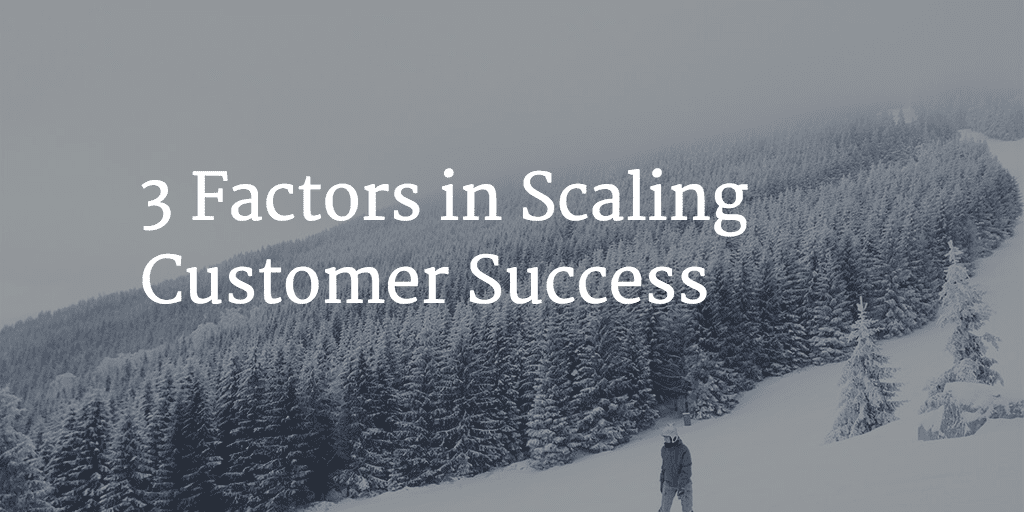Scaling Customer Success in your organization requires a mix of people, processes, and technology. And while that mix will be unique to your company, I’ve broken down the key inputs into that mix in this post.
Scaling Factor #1: The Right People
For Customer Success to really become part of your company’s DNA, it’s critical that everyone in your company – not just in the customer success management organization – clearly understands the desired outcome (which may vary across disparate customer segments / verticals) and how we as a company help the customers achieve that.
To make that happen, you need a strong Chief Customer Officer (CCO) or VP Customer Success that can:
- Sell the Customer Success vision internally
- Back that vision up by reporting on successes (and failures)
- Tie the value of the customer success organization (as much as possible) to agreed-upon metrics other executives and key stakeholders buy into
It’s easy to get excited about customer success at first; but a great customer success leader – in addition to finding and managing boots-on-the-ground Customer Success Managers (CSMs) and supporting operational roles – will know how to maintain and grow that excitement over time without losing momentum.
Obviously the leader of the organization is just one piece of the puzzle – it takes a village that includes CSMs on the front lines, operational support, customer marketing, etc. – but that’s just one example of why a strong leader is critical to scaling your Customer Success organization.
Scaling Factor #2: Repeatable Processes
When it comes to scaling any functional area of a company, centralizing and operationalizing repeating processes is absolutely critical.
But in scaling Customer Success, that is exponentially more important since we have not only a direct connection with the customer, but are ultimately responsible for their success… both as it relates to their desired outcome and the metrics that define them as a customer.
Two of the most important ways to scale your Customer Success organization are to centralize / operationalize processes and documentation on customer interactions. I’ve combined those both under this Scaling Factor for brevity.
The reality is, no Customer Success team will ever stand alone in its quest to improve retention and help customers achieve their desired outcome.
In fact, customer success requires more cooperation with, and assistance from, every other organization in the enterprise than any other group. And of course CSMs will often work with other CSMs.
So documenting a CSM’s interactions with a customer will ensure consistency from CSM to CSM, eliminating a lot of the redundant Q&A that customers can find annoying. And it will keep critical information from falling through the cracks.
If you want to take even more inconsistency out of the CSM to CSM hand-off process, further ensuring your customers will experience less pain, annoyance and disruption, then you need to ensure all your CSMs follow the same playbook or steps to take when a particular situation arises.
Documenting your processes, workflows, playbooks, etc. in one central location will ensure all CSMs work with all similar customers (a certain segment, cohort, etc.) the same way. This type of setup is critical for CSM-to-CSM handoffs. It’s absolutely a prerequisite for scaling a customer success management organization.
Scaling Factor #3: Technology
It’s often said that you should leverage technology where possible since it’s much more efficient to scale your technology stack than your humans. I look at it a different way for Customer Success: it’s much more efficient (and effective) to scale your humans when you leverage technology.
And of course there are various technologies you can leverage to effectively scale Customer Success; everything from a full-blown Customer Success Management product like Gainsight, to stand-alone tools that help you operationalize or automate both internal and customer-facing activities.
But on that latter point, some companies aren’t entirely sold on leveraging technologies like communication automation to scale their Customer Success organizations… something I find a bit odd.
I mean, if you think about it, all automation is – or should be – is what we’d do manually if we had unlimited time and resources. Automation should simply help you scale what you’d do manually if you could.
I hear all the time from companies that have “high-touch” models that they’d never “do automation” because it might hurt their relationship with the customer. I get it, but I see it as a misunderstanding of what automation is.
Remember, to some degree, if you’re a technology company, especially software or SaaS, you’re basically in the business of taking repetitive manual tasks and making those more efficient for your customers to complete. You’re in the automation business!
Think about a negative change to a customer’s health where automation triggers an email to the customer, by all appearances, sent directly from the CSM. It’s meant to start a conversation with the customer. Automation ensures the conversation is started at the right time; but it’s meant to drive a deeper human connection.
And for your low-revenue customers for whom it is not economically feasible to interact with in a higher-touch manner, automation is basically your only option if you really want to scale your operations.
While that’s just the tip of the iceberg, I hope that it helps you on the path to scaling your Customer Success organization.

